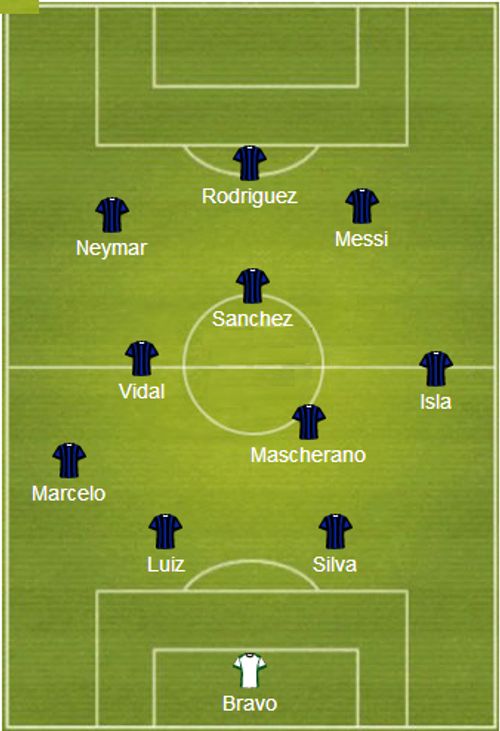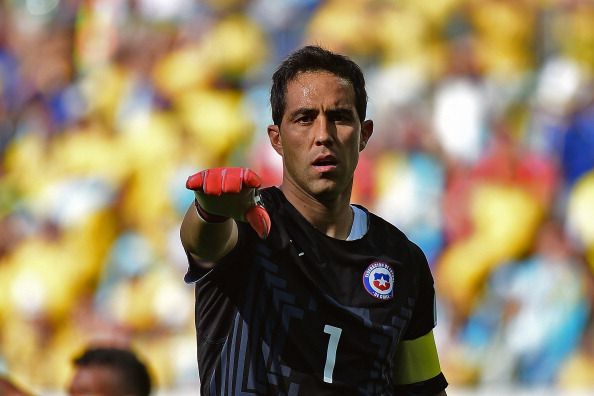
FIFA World Cup 2014: Best South American XI
South American teams have done fairly well this World Cup, with 5 qualifying for the knockouts, 4 making it to the Q/Fs and the Big Two - Brazil and Argentina – now in the semis. Former England goalkeeper Peter Shilton’s prediction that the final would be an all-South American affair could still materialize, although that would need both teams to step up a gear and stop depending on their main men. As the World Cup enters its final lap, a look at the best XI so far from the region:
Goalkeeper – Claudio Bravo
Bravo had an excellent domestic season with Real Sociedad, the most intense in the club’s history - 53 games. He certainly showed no signs of fatigue during his 4 World Cup outings, charging around his box to make crucial reaction saves and denying Robben, Neymar and Hulk. The Chile captain kept his country’s hopes alive till the very end, and was ultimately done in by the narrowest of margins in a penalty shootout.
Goalkeepers often mature late, and at 31, having just sealed a move to Barcelona, Bravo is clearly in the form of his life. Look out Ter Stegen, someone’s breathing down your neck!
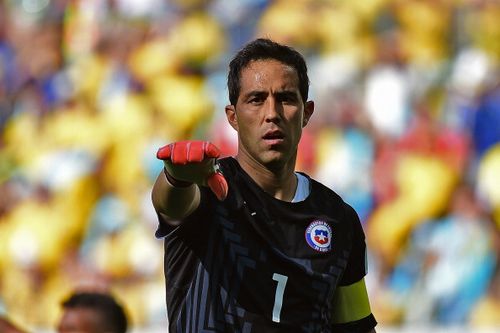
Defence: Mauricio Isla – Thiago Silva – David Luiz – Marcelo
Silva hasn’t been at his best in this last month, but that’s still good enough for Brazil. The hosts have conceded just 2 goals from open play in 5 games, and that is largely due to the PSG defensive general's skillful shepherding of his back-line and midfield. His absence from the semi-final isn’t getting the same headlines as Neymar’s, but will be no less damaging to Brazil.
Unlike his Brazil captain and future club teammate Silva, Luiz isn’t known as a pure defender – quite the opposite. He’s indisciplined in his positioning, and loves bombing forward. But his all-round utility is unquestionable: dramatic goal-line clearances; his physical, rampaging presence at the back; or scoring goals at key intervals.
His winner against Colombia was probably the best free kick of the tournament, and against Chile he stepped up to take the crucial first penalty in the shootout. In a team that celebrates individual talent, Luiz’s value is inspirational as much as technical.
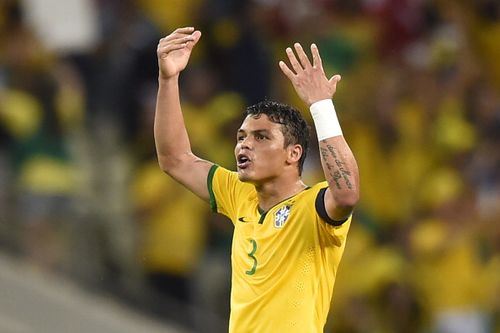
As Chile right-back, Isla has been quietly efficient, shutting down opposition wingers and getting the ball to the final third. He combines energy with technical ability and against Spain, he and Alexis Sanchez recorded the most frequent passing combination of the match. Against the Dutch, his intelligent positioning pushed Dirk Kuyt back into his own half, preventing any link-ups with Arjen Robben. His ability to play in midfield as well on the flanks was crucial for a side lacking depth.
Marcelo’s job this tournament has been to defend rather than attack, which is his more natural role. He’s been competent throughout - barring a slip-up against Croatia - and had his best game of the tournament against Colombia in the quarter-final, shackling the dangerous Juan Cuadrado. His primary job has been to cover for Neymar, who could run forward at will, knowing that Marcelo had his back in case of a counter-attack.
Midfield: Javier Mascherano – Arturo Vidal – Alexis Sanchez
The Argentina hard man may have passed the armband to Messi, but he is still very much the leader on the field. Impressively, he leads the tournament stats for both tackles made and passes attempted – an indicator of his talent as both creator and destroyer. That versatility has been critical for a side blessed in attack but highly deficient in defence and midfield. Mascherano has taken responsibility for both domains – he wins the ball and gives it to Messi, Higuain and co upfield. Argentina have registered 5 one-goal victories in a row – including three 1-0s – and Mascherano’s scrapping has helped maintain the advantage.
In this formation, Vidal would sit alongside Mascherano and burst forward to link up with the attackers. The Chilean midfielder is arguably the most complete player in the world, and his versatility has covered up Chile’s deficiencies across midfield. It hasn’t been easy for him to play so many roles, but his high-energy pressing destroyed Spain’s midfield, and he almost accomplished something similar against Brazil. His influence was especially felt by his absence. When he was substituted in the latter match (due to exhaustion), it meant Chile had to go through a shootout without the world’s most consistent penalty taker. They lost.
Sanchez completes the troika. Of course, he doesn’t really play like a central midfielder – his game is all about forward thrust and runs towards goal, not to mention terrific finishes – but he usually starts from midfield and accelerates, reaching top speed by the time he enters the penalty box – by when he is unstoppable. In this side he would play a number eight, a box-to-box midfielder.

Attack: Neymar – Lionel Messi – James Rodriguez
Neymar’s ability to rip apart defences through sheer pace and dribbling has been unmatched over the last month - and he’s done it mostly alone, relying on whatever service he gets; usually just seizing the ball and sprinting towards goal from inside-left. That sight may not be witnessed for several months again. We can be thankful when it happens: a broken vertebrae could have ended more than just his career.
For now his absence threatens to be one of the great World Cup tragedies. He cannot add to his tally of 4 goals (tied with Messi and Thomas Muller) this time; but no player has given Brazil more service.
At the start of the tournament, Messi hadn’t scored a World Cup goal in 8 years, and the pressure was mounting. Five games on, the world’s best player has scored 4 goals, delivered a match-winning assist and played probably the best pass of the tournament. He is Argentina’s most important player by a country mile, and the comparisons to Maradona’s triumphant ‘one-man team’ of 1986 are already being drawn. A simplistic analysis would be that Messi is to Argentina what Neymar is to Brazil. In reality, Messi is the evolved version of Neymar - a player who has perfected football’s most unique skill: the ability to control games with minimal movement.
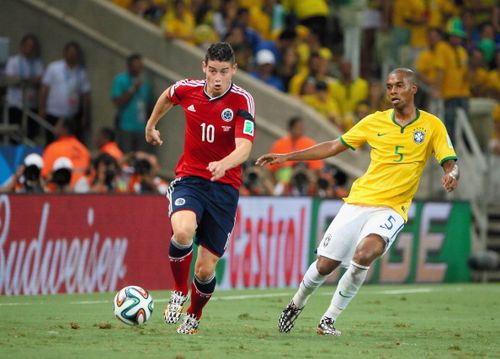
Rodriguez isn’t a recent find, but in a tournament dominated by number tens, his star has shone brightly. He has led the attack ably in the absence of Radamel Falcao, taking Colombia to the quarter-finals for the first time in their history; and his turn-and-shoot against Uruguay was, quite simply, the goal of the tournament. He can find space anywhere, dribble with both feet, shoot from a distance and bring others into the attack.
Against a brutally physical Brazil side on Friday, he still managed to deliver a man-of-the-match performance, albeit in a losing cause. Despite Colombia’s exit in the Q/Fs, Rodriguez’s 5 goals – the highest at a World Cup since Ronaldo’s 8 in 2002 – might be enough to win the Golden Boot; but most fan polls already have him down as the favourite for the Golden Ball. Few players have fired the public imagination the way Rodriguez has, and almost anything related to him now seems certain to make the headlines.
Manager: Jose Pekerman (Argentina)
Even by Latin American standards, it was unusual for Colombia’s President to personally request that the national team coach – a foreigner – be retained. He might still say no, but there is no denying that few managers have used their resources as astutely in this tournament. He coped with Falcao’s injury by coaxing the best out of Rodriguez, and fostered a style of play that reminded fans of Brazil at their very best – creative, attacking and fun to watch. That Brazil ultimately resorted to rugby tactics to stop Colombia playing ‘their’ way is perhaps the finest testament to Pekerman’s work.
Substitutes: Julio Cesar, Diego Godin, Luis Gustavo, Eduardo Vargas, Juan Cuadrado
